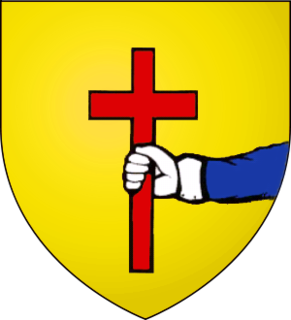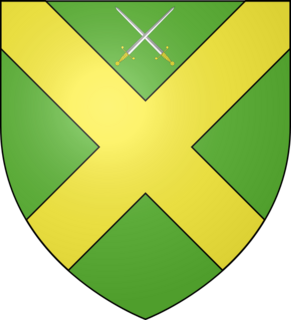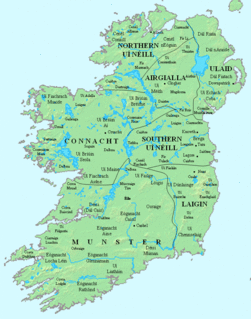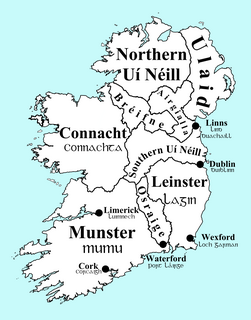 W
WDál Fiatach was a Gaelic dynastic-grouping and the name of their territory in the north-east of Ireland during the Middle Ages. It was part of the over-kingdom of Ulaid, and they were its main ruling dynasty for most of Ulaid's history. Their territory lay in eastern County Down. Their capital was Dún Lethglaise (Downpatrick) and from the 9th century their main religious site was Bangor Abbey.
 W
WDál nAraidi or Dál Araide, sometimes Latinised as Dalaradia or Anglicised as Dalaray, was a Cruthin kingdom, or possibly a confederation of Cruthin tribes, in north-eastern Ireland during the Middle Ages. It was part of the over-kingdom of Ulaid, and its kings often contended with the Dál Fiatach for the over-kingship of the province. At its greatest extent, the borders of Dál nAraidi roughly match those of County Antrim, and they seem to occupy the same area as the earlier Robogdii of Ptolemy's Geography, a region shared with Dál Riata. Their capital was Ráth Mór outside Antrim, and their eponymous ancestor is claimed as being Fiachu Araide.
 W
WThe Kingdom of East Breifne or Breifne O'Reilly was an historic kingdom of Ireland roughly corresponding to County Cavan that existed from 1256 to 1607. It took its present boundaries in 1579 when East Breifne was renamed Cavan, after Cavan town, and shired into Ulster. Originally part of the older Kingdom of Breifne, East Breifne came into existence following a protracted war between the ruling O'Rourke clan and the ascendant O'Reillys which culminated in the division of the kingdom in 1256. The Kingdom was ruled by the dynasty of the Ó Raghallaigh (O'Reilly) and lasted until the early 17th century.
 W
WGeoghegan is a surname of Irish origin.
 W
WIveagh is the name of several historical territorial divisions in what is now County Down, Northern Ireland. Originally it was a Gaelic Irish territory, ruled by the Uí Echach Cobo and part of the overkingdom of Ulaid. From the 12th century the Magennises were chiefs of Iveagh. They were based at Rathfriland and were inaugurated at Knock Iveagh. Following the Nine Years' War, the rulers of Iveagh submitted to the English Crown and the territory was divided between them. Iveagh became a barony, which was later split into Iveagh Lower and Iveagh Upper. The territory of Iveagh was also the basis of the Roman Catholic Diocese of Dromore.
 W
WMaguire is an Irish surname from the Irish language Mag Uidhir, which is "son of Odhar" or "son of the dun or dark coloured one". According to legend, the eleventh in descent from Colla da Chrich, great-grandson of Cormac mac Airt, monarch of Ireland about the middle of the third century. From the 13th to the 17th centuries, the Maguires were kings of Fermanagh.
 W
WThe O'Donnell dynasty were the dominant Irish clan of the kingdom of Tyrconnell, Ulster, in medieval and early-modern Ireland.
 W
WO'Keeffe, also O'Keefe, Keef, Keefe or Keeffe, is the name of an Irish Gaelic clan based most prominently in what is today County Cork, particularly around Fermoy and Duhallow. The name comes from caomh, meaning "kind" or "gentle"; some reformed spellings present it as Ó Cuív and the feminine form of the original is Ní Chaoimh. As the primary sept of the Eóganacht Glendamnach, the family were once Kings of Munster from the 6th to the 8th centuries.
 W
WO'Rourke is an Irish Gaelic clan based most prominently in what is today County Leitrim. The family were the historic rulers of Breifne and later West Breifne until the 17th century.
 W
WThe O'Byrne family is an Irish clann that descend from Bran mac Máelmórda, King of Leinster, of the Uí Faelain of the Uí Dúnlainge. Before the Norman invasion of Ireland they began to colonise south Wicklow. There are many famous people with this Irish last name. This includes Anna O’Byrne, an Australian singer and actress, and Anna Marie O’Byrne, an American model.
 W
WThe O’Doherty family is an Irish clan based in County Donegal in the north of the island of Ireland.
 W
WThe O'Donoghue of the Glens, Prince of Glenflesk, is the hereditary chieftain of his sept of the Kerry Eóganacht, Munster, Ireland. In 1944, his father was one of the few Chiefs of the Name recognized by Edward MacLysaght, the first Chief Herald, as having a verifiable pedigree and entitled to use the title and receive courtesy recognition by the Irish State.
 W
WO'Dowd is an Irish Gaelic clan based most prominently in what is today County Mayo and County Sligo. The clan name originated in the 9th century as a derivative of its founder Dubda mac Connmhach. They descend in the paternal line from the Connachta's Uí Fiachrach. The immediate progenitors of the O'Dowd were Kings of Connacht during the 7th and 8th centuries in the form of Dúnchad Muirisci, Indrechtach mac Dúnchado, Ailill Medraige mac Indrechtaig and Donn Cothaid mac Cathail, before losing ground to their rivals the Uí Briúin.
 W
WO'Sullivan is an Irish Gaelic clan based most prominently in what is today County Cork and County Kerry. The surname is associated with the southwestern part of Ireland, and was originally found in County Tipperary and Kerry before the Anglo-Norman invasion. It is the third most numerous surname in Ireland. Due to emigration, it is also common in Australia, North America, Britain, and the rest of the world.
 W
WThe O'Toole family of Leinster, formerly one of the leading Royal families of that province, descended from Tuathal Mac Augaire, King of Leinster, of the Uí Dúnlainge dynasty.
 W
WUí Fhiachrach Aidhne was a kingdom located in what is now the south of County Galway.
 W
WUlaid or Ulaidh was a Gaelic over-kingdom in north-eastern Ireland during the Middle Ages made up of a confederation of dynastic groups. Alternative names include Ulidia, which is the Latin form of Ulaid, and in Cóiced, Irish for "the Fifth". The king of Ulaid was called the rí Ulad or rí in Chóicid.
 W
WThe Kingdom of West Breifne or Breifne O'Rourke was a historic kingdom of Ireland that existed from 1256 to 1605, located in the area that is now County Leitrim. It took its present boundaries in 1583 when West Breifne was shired and renamed Leitrim, after the village of Leitrim, which was an O'Rourke stronghold. The kingdom came into existence after a battle between the ruling O'Rourke clan and the ascendant O'Reillys caused the breakup of the older Kingdom of Breifne and led to the formation of East Breifne and West Breifne. The kingdom was ruled by the O'Rourke clan and lasted until the early 17th century, when their lands were confiscated by England.